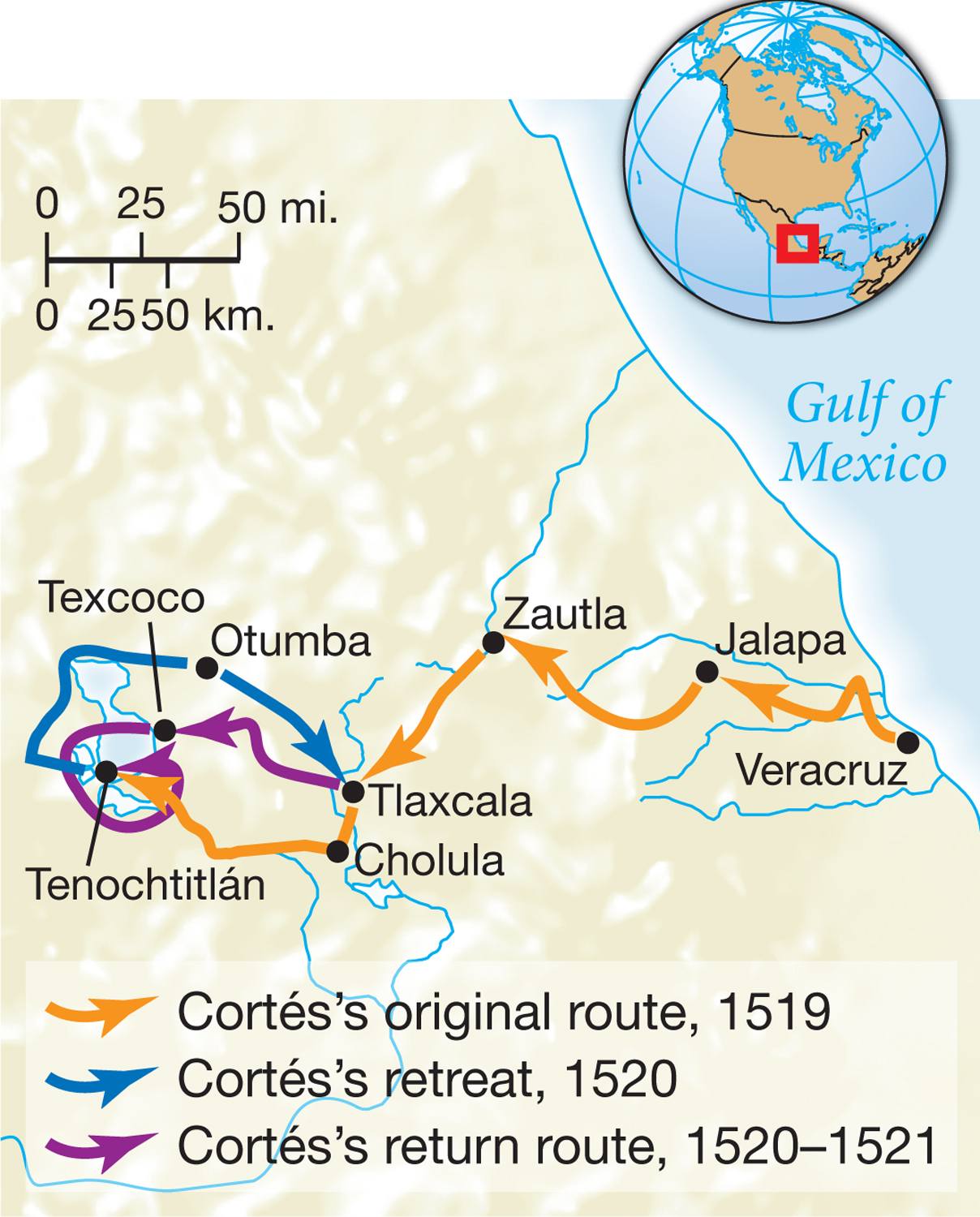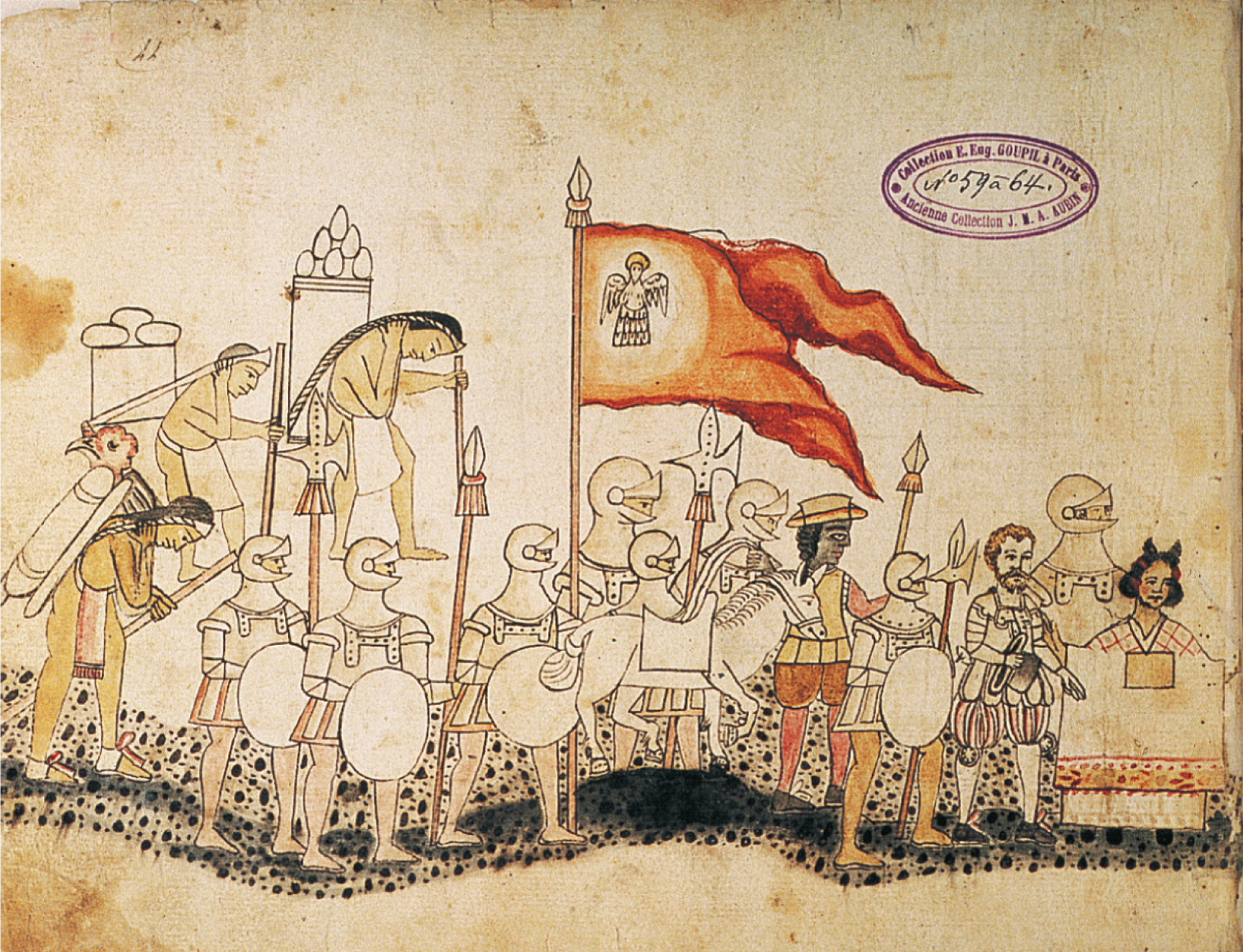The American Promise:
Printed Page 34
The American Promise Value
Edition: Printed Page 35
The Conquest of Mexico
Hernán Cortés, an obscure nineteen-
A charismatic and confident man, Cortés could not speak any Native American language. Landing first on the Yucatán peninsula with his ragtag army, he had the good fortune to receive from a local Tobascan chief the gift of a young girl named Malinali. She spoke several native languages, including Nahuatl, the language of the Mexica, the most powerful people in what is now Mexico and Central America (see “The Mexica: A Mesoamerican Culture” in chapter 1). Malinali, whom the Spaniards called Marina, had acquired her linguistic skills painfully. Born into a family of Mexican nobility, she learned Nahuatl as a child. After her father died and her mother remarried, her stepfather sold her as a slave to Mayan-

In Tenochtitlán, the capital of the Mexican empire, the emperor Montezuma heard about some strange creatures sighted along the coast. (Montezuma and his people called themselves Mexica.) The emperor sent representatives to bring the strangers large quantities of food. But along with the food, the Mexica also brought the Spaniards another gift, a “disk in the shape of a sun, as big as a cartwheel and made of very fine gold,” as a Mexican recalled. Here was conclusive evidence that the rumors of fabulous riches heard by Cortés had some basis in fact.
In August 1519, Cortés marched inland to find Montezuma. Leading about 350 men, Cortés had to live off the land, establishing peaceful relations with indigenous tribes when he could and killing them when he thought it necessary. On November 8, 1519, Cortés reached Tenochtitlán, where Montezuma welcomed him and showered the Spaniards with lavish hospitality. Quickly, Cortés took Montezuma hostage and held him under house arrest, hoping to make him a puppet through whom the Spaniards could rule the Mexican empire. This uneasy peace existed for several months until one of Cortés’s men led a brutal massacre of many Mexican nobles, causing the people of Tenochtitlán to revolt. Montezuma was killed, and the Mexica mounted a ferocious assault on the Spaniards. On June 30, 1520, Cortés and about a hundred other Spaniards fought their way out of Tenochtitlán (losing much of the gold they had confiscated since it proved too heavy to carry away in haste) and retreated about one hundred miles to Tlaxcala, a stronghold of bitter enemies of the Mexica. The Tlaxcalans—
In the spring of 1521, Cortés and thousands of Indian allies laid siege to the Mexican capital. With a relentless, scorched-

How did a few hundred Spaniards so far away from home defeat millions of Indians fighting on their home turf? For one thing, the Spaniards had superior military technology that partially offset the Mexicans’ numerical advantages. (See “Visualizing History.”) They fought with weapons of iron and steel against the Mexicans’ stone, wood, and copper. The muscles of Mexican warriors could not match the power of cannons and muskets fueled by gunpowder.
European viruses proved to be even more powerful weapons. Smallpox arrived in Mexico with Cortés, and in the ensuing epidemic thousands of Mexicans died and many others became too sick to fight. The sickness spread along the network of trade and tribute feeding Tenochtitlán, causing many to fear that their gods had abandoned them. “Cut us loose,” one Mexican pleaded, “because the gods have died.”
The Spaniards’ concept of war also favored them. Mexicans tended to consider war a way to impose their tribute system on conquered people and to take captives for sacrifice. They believed that the high cost of continuing to fight would cause their adversaries to surrender and pay tribute. In contrast, Spaniards sought total victory by destroying their enemy’s ability to fight.
Politics proved decisive in Cortés’s victory over the Mexicans. Cortés shrewdly exploited the tensions between the Mexica and the people they ruled in their empire (see chapter 1). Cortés reinforced his small army with thousands of Indian allies who were eager to seek revenge against the Mexica. Hundreds of thousands of other Indians aided Cortés by failing to come to the Mexicans’ defense. In the end, the political tensions created by the Mexican empire proved to be its crippling weakness.